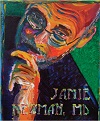Scorbitus
Three cases, one diagnosis.
Dr. Lundstrom sat in the hospital room contemplating his new patient. The man had been admitted with edema and bruising and several oral diseases. He had a history of alcohol and opioid abuse. The admitting diagnosis was methamphetamine abuse, coagulopathy, and possible nephrotic syndrome versus congestive heart disease. Something did not seem to add up.
***

Five centuries earlier, somewhere in the forests of North America, Simone Cartier was cold, tired, and hungry. How had he ended up in the middle of this godforsaken continent, feeling lost and hopeless? His legs were swollen, and he realized he couldn't have taken off his shoes if he wanted to. With winter coming, he was sure he would lose his feet to frostbite anyway, if he managed to survive. He couldn't take another step and sank to the ground, his back against a pine tree.
Nearby, Enkoodabaoo (“He Who Walks Alone”) moved quietly through the woods. He had heard what sounded like a man stumbling and falling. He preferred his solitude, but he would not forgo aiding someone in trouble. He came upon an odd-looking, strangely dressed man, slumped against a tree. This person would die if left alone in the woods. Enkoodabaoo quickly realized what was wrong and began to slice large strips of bark and branches of pine needles from the tree. He removed his pack and began to set up a rough camp, as the man was too big to move.
Over a small fire, Enkoodabaoo made a tea of bark and pine needles. Saying a brief prayer, he poured a small amount and got the stranger to sip it. At first the man struggled against the bitter liquid, but eventually he swallowed the whole cup. Enkoodabaoo ground some onion and venison into a fine paste and gave the man small mouthfuls that he could swallow without chewing. Three times a day for a week he drank the tea, and by the end of that time, he was able to walk on his own. Enkoodabaoo was glad to see him on his way, though he doubted he would ever make it back to his own people.
***
The captain of HMS Salisbury knew something had to be done; 80 members of his 350-man crew had fallen ill. It was 1747. He was in the middle of the North Atlantic. His men were exhausted, and even their small lacerations bled freely. They were losing their teeth and unable to eat their rations of dried meat and hard bread. It had been two months since landfall, and they needed a solution. James Lind, his Scottish surgeon's mate, had an interesting idea. Twelve men were selected for an experiment.
Lind was convinced there was a cure for scorbitus, a condition that especially plagued sailors after months at sea. The signs were clear: the swollen gums, the odd twisted hair, the bruising and fatigue. Many treatments had been tried, and it was unclear which ones were actually effective.
For his experiment, he would take six pairs of sailors and place them together in the same space. He would give them all the same food and water, but each got a different additional treatment: a quart of cider daily; twenty five drops of elixir of vitriol thrice daily; half a pint of seawater daily; a nutmeg-sized paste of garlic, mustard seed, horseradish, balsam of Peru, and gum myrrh thrice daily; two spoonfuls of vinegar thrice daily; or two oranges and one lemon a day. He would see if any of the men recovered.
Sailor Simon Northup was tired of the navy, tired of the ocean, and just plain tired. He barely noticed as they carried him down to the hold with eleven other men. A friend of his was assisting the surgeon's mate. He was worried Simon would die if forced to drink a pint of saltwater, so he had made sure that his friend would be assigned to one of the other groups. The one with the fruit sounded the best.
After a few days Simon began to feel stronger. He no longer needed others to take care of him, and by the end of the week he was helping care for the sailors who had lived through the experiment. He was forever grateful to his friend and loved oranges till the end of his long life.
***
Dr. Lundstrom began to take a careful history. When he asked about diet, the patient laughingly responded that it used to be “meth, coke, weed, and booze,” but he had quit all of that two years ago, though nobody seemed to believe him, especially his ex-wife. He got all his food from the local convenience store.
The lab and echo didn't support the admission diagnosis. Dr. Lundstrom asked for more specifics about diet, and the patient replied that he bought the cheapest things he could: dollar hot dogs and slushies. Dr. Lundstrom grabbed his phone and looked up the nutritional value of these foods: no vitamin C. After initiating treatment with high-dose oral vitamin C, he stressed the importance of consuming certain nutrients. The patient said they did not sell oranges at the convenience store, but bananas were inexpensive, and he had a friend who worked at a bar and could bring him slices of lime.
Three patients in three separate eras, one diagnosis: Scurvy.



